Versko in kulturno sredi¹èe Melbourne

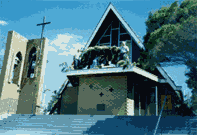
ADVENT
Advent is a holy time, the time of concentration, meditation and preparations for the birth of Christ. The activities which disturb the concentration ceased in Slovenia at Advent. There were times, when marriages were not celebrated and some people abstained from food. In church a special Morning Mass was celebrated named ZORNICE (SVITANICE) – the Early Mass. Families gathered together to pray the Joyous part of the Rosary and to sing the Advent songs especially VI OBLAKI (You, the Clouds) by Janez Traven, KEDAJ ZVELICAR PRISEL BOS (When Are You Coming, Savior?) by Angelik Hribar; POSLAN Z NEBES JE ANGEL (The Angel is Sent from Heaven) by Martin Zeleznik: VSO ZEMLJO TEMA KRIJE (All the Earth is Covered in Darkness) by Matija Tomc or PRIDI RESENIK SVETA (Come, the Savior of the World) by Karlo Adamic.
Slovenians spend Advent in preparing for Christmas and in collecting materials for making the Nativity set. In Slovenian churches and in private homes the Advent Wreath is quite new and is in the last few decades prepared with greenery and candles.
ST. NICHOLAS
On the Eve of St. Nicholas (6th December), the children were all well behaved, frightened by the visit of MIKLAVZ (St. Nicholas) and his companion angels and the HUDICI (devils). At first the bells are heard from the road, amongst the ringing the chains are heard. Children keep close to their mothers, and the fathers usually wait at the door. The angels carry a big book with the names of well-behaved children, and of those, who were naughty. The angels carry the presents and the devils jump and hop around the house. Miklavz is dressed in a long coat (Bishop’s coat), has a bishop’s hat on his head, white gloves and in his left hand is a long, gilded bishop’s stick. From the book he reads the names of the children who were good and praises them while naughty ones are told to be better. The children are asked questions from the Catechism and to say prayers. For the diligent children there are usually presents such as walnuts, biscuits (in the shape of angels and devils) or similar, but for the naughty ones there is only MIKLAVZEVA SIBA – a stick, often decorated with ribbon. Sometimes devils put naughty children into a basket and carry them, chain them and drag them along for a while. Since the Second World War Miklavz appears only in some villages and among Slovenians living in other countries.
CARRYING OF A STATUE OF MARY
A very old custom is also known in Slovenia named MARIJO NOSIJO – carrying of a statue of Mary. The custom reminds us of the travels of the pregnant Mary and Joseph, combined with the celebration of the ‘Nine days of Christmas’. The statue of Mary spent each night with a different family, being honoured each evening with the home devotions (praying of the Rosary, litanies and singing of hymns).
JASLICE - The Nativity Set
Every Slovenian home had a special place in the house, where the cross was put throughout the year. In the month of May the statue of Mary was put in that special place and at Christmas this was also the site for jaslice. In some parts of Slovenia the wheat is sown in a small dish and put in the special jaslice place. Throughout Advent the moss, bark, small pretty stones, twigs and branches of fir trees are gathered, followed by the making of the simple stable with a straw covered roof, painting of the figures of Mary, Joseph, baby Jesus, together with shepherds, oxen and donkey, sheep, shepherd’s dogs, camels and the Three Kings.
The first jaslice was prepared by Jesuits in 1560 at Coimbra (Portugal). The first church in Slovenia to have jaslice was St. Jakob in Ljubljana in 1644, and the Chronicle describes the figures as being very tall. In later years the figures were painted on boards or were made of paper.
Maksim Gaspari: jaslice (Nativity set)
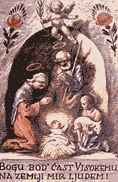

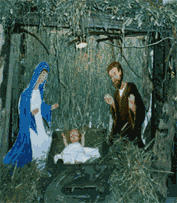

The first written account of jaslice by A. Praprotnik in a private home comes from 1848. He states that Slovenians put jaslice in a triangular form in a corner of the house, with the town of Bethlehem on a little hill, and below the stable – STALICA. The figures of Mary, Joseph and baby Jesus are in Slovenian Nativity set placed in the stable and not in the cave as in most countries. The figures were sometimes made of wood, wax or paper, sometimes of painted pottery. The important part of Slovenian jaslice is the linen cloth (sometimes molded from wood and hand painted) – PRTICEK.
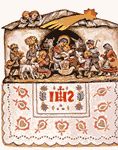
There was no home in Slovenia without jaslice and the Slovenians living in other countries still keep the tradition very much alive. Under the Christmas tree today in Slovenian homes are always jaslice, prepared on Christmas Eve.
In Slovenia a small fir tree was hung in the BOHKOV KOT (God’s little corner) of every house. The tree was not decorated, and neither was the small fir tree that was sometimes put on a fence. The fir tree was named KRISPAN.
The BOZICNO DREVESCE (the Christmas tree) was unknown in Slovenia until the First World War.
CHRISTMAS EVE
Preparations for Christmas Eve continue with the cleaning of the house and the surroundings. Christmas Eve has a different name according to the region of Slovenia. Special Christmas cake (or more cakes) BOZICNIK are baked, named also POPRTNIK. The Christmas cake was put on a table, covered with a white cloth and the family gathered for meals at another, less prominent place. At the Morning Mass people collected blessed water to take home for the evening blessing of their homes at the time of the Three Holy Evenings (Christmas Eve, New Years Eve and before the Feast of the Epiphany). The table with Bozicnik was blessed and not to be touched or used until the Feast of the Epiphany.
The first Holy Evening - Christmas Eve begins at dusk. The bells begin to ring. In the homes the blessing of the house and surrounding buildings with the holy water begins, followed by incense burning. The whole family follows praying on the way. After the blessing the family sits at the table for a simple meal. Waiting for Christ’s Birth follows with the singing of songs, Christmas carols and readings from the Bible.
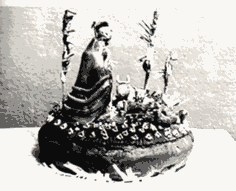
MIDNIGHT MASS – POLNOCNICA
The whole family usually goes to Midnight Mass except one member, who stays as a guardian of the house. The bells toll and the church is well lit in the winter night. Many Christmas songs are sung. In Slovenia more than 80 Christmas songs are known, most of them unique. After the return from Mass the family has a warm meal, most of the time KOLINE – the black pudding sausages.
There were no presents on Christmas Eve in Slovenia except sometimes an orange for the whole family, walnuts and hazelnuts or dried apples.
Some Slovenian Christmas songs – Carols date back to the 15th century, with the ENO DETE JE ROJENO (The One Baby is Born) being the oldest known Slovenian Christmas song.
The later traditional Slovenian Christmas carols are sung every Christmas, such as
DETE RAJSKO (The Heavenly Child) by Eleonora Hudovernik:
CHRISTMAS DAY
The Christmas Day is the holiest day of the year and people do not work around their homes. In some regions of Slovenia, visitors on Christmas Day mean a bad omen. The Christmas Day is for the family; wishing each other Merry Christmas was at Mass time and then people went to their homes, to celebrate the Birth of Jesus in their hearts and welcome Him into their families. People never went visiting on Christmas Day, not even neighbours. They only went to church and then home again. There was a celebration meal at noon. The next day people went visiting to see and admire each other’s jaslice.

Under the Communists Christmas day in Slovenia was an official working and school day. Only since the Independence of Slovenia, 1991, is Christmas day a public holiday.
SECOND HOLY EVENING – NEW YEAR’S EVE
On New Years Eve the blessings of the houses and surroundings were repeated as per Christmas Eve.
After New Year the KOLEDNIKI – the messengers of well wishes were walking from home to home, singing traditional songs. These songs date to the Middle ages and are unique to each Slovenian region.
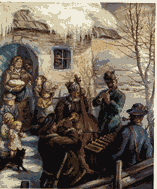
THE THIRD HOLY EVENING – THE EPIPHANY
The Eve before the Feast of the Epiphany the blessings of the houses and surroundings were repeated for the third time. On the door-posts the new date was written with chalk and the initials of the Three Kings. (Example for next Christmas: 20 G + M + B 00).
The Three kings: Caspar, Melchior, Balthazar were added to the jaslice, symbolizing their arrival at the stable to see and honour baby Jesus.
The Christmas Season in Slovenia ends on 2nd February, on the day of the Presentation of the Lord (SVECNICA), and until that time Christmas songs and Carols are sung, and the jaslice stay set in the corner until that Feast.
Acknowledgements:
Maksim Gaspari is a well known Slovenian artist (1883 –1973?)
The songs were sung by different choirs as: Ljubljanski oktet, Slovenski komorni zbor, Deseti brat oktet,
Nativity set at Slovenian Religious and Cultural Centre, Kew, painted by Draga Gelt, prepared by Lucija and Stefan Srnec, and Lojze Jeric, 2 songs prepared by Lenti Lenko.
For further information, tapes or CDs of Slovenian Christmas songs contact
Slovenian Religious and Cultural Centre or
Baraga House Library,
both at 19A’Beckett Street, Kew, Victoria 3101, Australia,